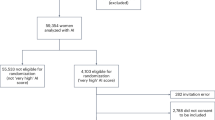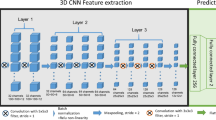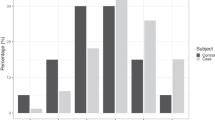Abstract
We know that screening for breast cancer leads to detection of smaller tumours with less lymph node metastases. Could it be possible that the decrease in mortality after screening is not only caused by this earlier stage, but also by a different mitotic activity index (MAI) of the tumours that are detected by screening? Is MAI a prognostic factor for recurrence-free survival? A retrospective study was carried out of 387 patients with breast cancer, treated at the University Hospital Nijmegen between January 1992 and September 1997. Ninety patients had screen-detected breast cancer, 297 patients had breast cancers detected outside the screening programme. The MAI, other prognostic factors and recurrence-free survival were determined. In non-screen-detected tumours the MAI is twice as high as in screen-detected tumours, even after correction for age took place. The MAI correlated well with other tumour characteristics. The MAI in itself is a prognostic factor for recurrence-free survival. Favourable outcome in screen detected breast cancer is not entirely caused by detecting cancer in early stages: quantitative features such as the MAI indicate a less malignant character of screen detected breast cancer. The MAI is an independent prognostic factor for recurrence-free survival. © 2000 Cancer Research Campaign
Similar content being viewed by others
Article PDF
Change history
16 November 2011
This paper was modified 12 months after initial publication to switch to Creative Commons licence terms, as noted at publication
References
Aaltomaa S, Lipponen P, Eskelinen M, Alhave E and Syrjänen K (1991) Nuclear morphometry and mitotic indexes as prognostic factors in breast cancer. Eur J Surg 157: 319–324
Aaltomaa S, Lipponen P, Eskelinen M, Kosma VM, Marin S, Alhava E and Syrjänen K (1993) Predictive value of a morphometric prognostic index in female breast cancer. Oncology 50: 57–62
Baak JPA (1985) The relative prognostic significance of nucleolar morphometry in invasive ductal breast cancer. Histopathology 9: 437–444
Baak JPA, Dop van H, Kurver PHJ and Hermans J (1985) The value of morphometry to classic prognosticators in breast cancer. Cancer 56: 374–382
Baak JPA (1989) The multicenter morphometric mammary carcinoma project (MMMCP): a nation wide prospective study on reproducibility and prognostic power of routine quantitative assessments in the Netherlands. Pathol Res Pract 185: 664–670
Baak JPA, Wisse-Brekelmans ECM, Kurver PHJ, Gorp van LHM, Voorhorst FJ and Miettinen BS (1992) Regional differences in breast cancer survival are correlated with differences in differentiation and rate of proliferation. Hum Pathol 23: 989–992
Baak JPA, Diest van PJ, Benraadt T, Matze-Cok E, Brugghe J, Schuurmans LT and Littooy JJ other MMMCP collaborators (1993) The multi-center morphometric mammary carcinoma project (MMMCP) in the Netherlands: value of morphometrically assessed proliferation and differentiation. J Cell Biochem Suppl 17G: 220–225
Borras JM, Espinas JA, Beemsterboer PM, Granados A and Koning de HJ (1998) Anticipating the consequences for the primary therapy of breast cancer after introducing screening. A more global picture for health care policy making. Int J Technol Assess Health Care 14: 268–276
Collan YUI (1996) Standardized mitotic counts in breast cancer. Evaluation of the method. Pathol Res Pract 192: 931–941
Diest van PJ (1992a) Reproducibility of mitosis counting in 2,469 breast cancer specimens: results from the multicenter morphometric mammary carcinoma project. Hum Pathol 6: 603–607
Diest van PJ, Fleege JC and Baak JPA (1992b) Syntactic structure analysis in invasive breast cancer: analysis of reproducibility, biologic background and prognostic value. Hum Pathol 23: 876–883
Diest van PJ, Baak JPA, Matze-Cok P and Bacus SS (1992c) Prediction of response to adjuvant chemotherapy in premenopausal lymph node positive breast cancer patients with morphometry, DNA flow cytometry and Her-2/Neu oncoprotein expression. Pathol Res Pract 188: 344–349
Dijck van JA, Broeders MJ and Verbeek AL (1997a) Mammographic screening in older women. Is it worthwhile?. Drugs Aging 10: 69–79
Dijck van JA, Verbeek AL, Beex LV, Hendriks JH, Holland R, Mravunac M, Straatman H and Werre JM (1997b) Breast-cancer mortality in a non-randomized trial on mammographic screening in women over age 65. Int J Cancer 70: 164–168
Elwood JM, Cox B and Richardson AK (1993) The effectiveness of breast cancer screening by mammography in younger women. Online J Curr Clin Trials: Doc No 32,
Elston CE (1987) Grading of invasive carcinoma of the breast. In: Diagnostic Histopathology of the Breast, Page DL, Anderson TJ (eds), pp. 300–307. Churchill Livingstone: Edinburgh
Fracheboud J, Koning de HJ, Beemsterboer PM, Boer R, Hendriks JH, Verbeek AL, Ineveld van BM, Bruyn de AE and Maas van der PJ (1998) Nation-wide breast cancer screening in the Netherlands: results of initial and subsequent screening 1990–1995. National Evaluation Team for Breast Cancer Screening. Int J Cancer 75: 694–698
Freund KM, Burns RB and Antab L (1998) Improving residents’ performances of clinical breast examination. J Cancer Educ 13: 20–25
Harris KM and Vogel VG (1997) Breast cancer screening. Cancer Metastasis Rev 16: 231–262
Jannink I, Diest van PJ and Baak JPA (1995) Comparison of the prognostic value of four methods to assess mitotic activity in 186 invasive breast cancer patients. Hum Pathol 26: 1086–1092
Linden van der HC, Baak JPA, Lindeman J, Hermans F and Meyer CLJM (1986) Morphometry and breast cancer. II. Characterisation of breast cancer cells with high malignant potential in patients with spread to lymph nodes: preliminary results. J Clin Pathol 39: 603–609
Linden van der JC, Baak JPA, Lindeman J, Hermans J and Meyer CJLM (1987) Prospective evaluation of prognostic value of morphometry in patients with primary breast cancer. J Clin Pathol 40: 302–306
Linden van der JC, Lindeman J, Baak JPA, Meijer CJLM and Herman CJ (1989) The multivariate prognostic index and nuclear DNA content are independent prognostic factors in primary breast cancer patients. Cytometry 10: 56–61
Maestro C, Cazenave F, Marcy PY, Bruneton JN, Chauvel C and Bleuse A (1998) Systematic ultrasonography in asymptomatic dense breasts. Eur J Radiol 26: 254–256
Peer PG, Verbeek AL, Straatman H, Hendriks JH and Holland R (1996) Age-specific sensitivities of mammographic screening for breast cancer. Breast Cancer Res Treat 38: 153–160
Peeters PHM, Miltenburg GAJ, Fracheboud J, Gimbrère CHF, Hogervorst JMW and Colette HJA (1998) Seventeen-year evaluation of breast cancer screening: the DOM project, the Netherlands. Br J Cancer 78: 962–965
Schroën AMA, Wobbes TH and Sluis van der RF (1996) Interval carcinomas of the breast: a group with intermediate outcome. J Surg Oncol 63: 141–144
Schroën AMA, Wobbes TH and Sluis van der RF (1998) Infiltrating lobular carcinoma of the breast detected by screening. Br J Surg 85: 390–392
Smart CR (1992) Mammographic screening: efficacy and guidelines. Curr Opin Radiol 4: 108–117
Tabàr L (1985) Reduction in mortality from breast cancer after mass screening with mammography. Randomised trial from the Breast Cancer Screening Working Group of the Swedish National Board of Health and Welfare. Lancet 1: 829–832
Theissig F, Baak JPA, Schuurmans L, Haroske G, Meyer W and Kunze KD (1996) Blind multicenter evaluation of the prognostic value of DNA image cytometric and morphometric features in invasive breast cancer. Anal Cell Pathol 10: 85–99
Uyterlinde AM, Schipper NW and Baak JPA (1987) Comparison of extent of disease and morphometric and DNA flow cytometric prognostic factors in invasive ductal breast cancer. J Clin Pathol 40: 1432–1436
Uyterlinde AM, Schipper NW, Baak JPA, Peterse H and Matze E (1988) Limited prognostic value of cellular DNA content to classical and morphometrical parameters in invasive ductal breast cancer. Am J Clin Path 89: 301–307
Uyterlinde AM, Baak JPA, Schipper NW, Peterse H, Matze E and Meyer CJL (1990) Further evaluation of the prognostic value of morphometric and flow cytometric parameters in breast-cancer patients with long follow-up. Int J Cancer 45: 1–7
Verbeek ALM, Hendriks JHCL, Holland R, Mravunac M, Sturmans F and Day NE (1984) Reduction of breast cancer mortality through mass screening with modern mammography. First results of the Nijmegen project, 1975–1981. Lancet 1: 1222–1224
Wolfe JN (1991) Breast cancer screening. A brief historical review. Breast Cancer Res Treat 18: 89–92
Author information
Authors and Affiliations
Rights and permissions
From twelve months after its original publication, this work is licensed under the Creative Commons Attribution-NonCommercial-Share Alike 3.0 Unported License. To view a copy of this license, visit http://creativecommons.org/licenses/by-nc-sa/3.0/
About this article
Cite this article
Groenendijk, R., Bult, P., Tewarie, L. et al. Screen-detected breast cancers have a lower mitotic activity index. Br J Cancer 82, 381–384 (2000). https://doi.org/10.1054/bjoc.1999.0930
Received:
Revised:
Accepted:
Published:
Issue date:
DOI: https://doi.org/10.1054/bjoc.1999.0930
Keywords
This article is cited by
-
Defining the area of mitoses counting in invasive breast cancer using whole slide image
Modern Pathology (2022)
-
Long-term prognosis of breast cancer detected by mammography screening or other methods
Breast Cancer Research (2011)
-
Predictive Value of Tumor Proliferative Indices in Periampullary Cancers: Ki‐67, Mitotic Activity Index (MI) and Volume Corrected Mitotic Index (M/V) Using Tissue Microarrays
World Journal of Surgery (2010)
-
Receipt of adjuvant systemic therapy among patients with high-risk breast cancer detected by mammography screening
Breast Cancer Research and Treatment (2009)
-
Preoperative selection of symptomatic breast cancer patients appropriate for lymphatic mapping and sentinel node biopsy
Irish Journal of Medical Science (2007)



